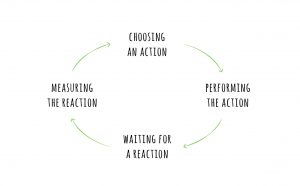An attribution model is the rule, or set of rules, that determines how credit for sales and conversions is assigned to touch points in conversion paths. It’s a useful tool for marketers, because modelling attribution helps you to understand how a conversion funnel is working, and how best to optimize your campaign reporting. With an attribution model, you can better plan your budget and spend allocation.
To help you get started with attribution modelling, we’re covering the basics: what an attribution model is, types of models, and their benefits.
What is Attribution Modelling
Attribution in marketing is the way in which marketers assess the value or return on investment (ROI) of the channels that connect them to potential customers. With attribution, you’re able to see how your customers are coming to know and buy your product or service. An attribution model is one method for uncovering this information.
An attribution model does this by identifying a set of user actions that contribute to a desired outcome. Then, attribution assigns a value to each of these events. For example, last-touch attribution gives conversion credit to the final touch point where a lead has converted from. So, if a lead clicked through to your landing page from a native ad, and made a purchase, the attribution model would assign credit for that conversion to that native ad.
Digital marketing attribution is important because it makes the marketing realm less complex. With so many mediums, channels, and demographics of customers, it can be hard to know exactly where or how to focus your efforts. Attribution models provide a way of understanding where your efforts are most successful, enabling you to optimize your conversion funnel. By creating an attribution model, you can determine the ROI associated with each of your marketing channels and determine whether more resources or spend should be assigned to one specific channel.
Types of Attribution Models
There are various types of attribution models that marketers can rely on. Which model you use depends on your business, your vertical, and the journey that your prospects take to become customers. Before getting into specific types of attribution models, it’s important to distinguish between single-touch and multi-touch models.
A single-touch model evaluates a single touch point where the engagement that is given credit for the sale is either the first or last interaction a customer will have with the company’s campaign. These models are great for understanding how your customer’s journey either begins (how they come to find your business) or what final event results in conversion.
Multi-touch attribution models are more complex. They typically feature multiple engagements where varying degrees of credit are given to various touch points, which eventually lead to a sale. A multi-touch attribution model will often include first and last touch points as part of the customer journey.
Common Attribution Models
There are 6 attribution models that are commonly used, and they range in purpose and in complexity.
- First-click attribution: This model assigns credit to the first marketing touch point, the channel or activity that acquired contact with a customer. This model is easy to implement, and is useful for uncovering how customers and leads are initially finding your business.
- Last-click attribution: With this model, all the credit goes to the customer’s last touch point before converting. This model is easy to implement, and is useful for understanding at what touch point a lead converts, especially within a short sales cycle.
- Linear attribution: This is a multi-touch attribution model, which makes it more complex than first and last touch models. It takes into account and attributes credit to multiple touch points along the customer journey. In most cases, you want this model to take into account every single interaction that a prospect has with your business prior to conversion. This model is more complicated to implement, but it provides a more detailed and whole picture of your customer’s journey. This model can be used in tandem with first and last touch, and it’s especially useful for long consideration windows.
- Time decay attribution: Time decay attribution is a multi-touch attribution model that gives varying amounts of credit to all the channels and touch points that led to your customer converting. The amount of credit that is assigned decreases the further back in time that the channel was interacted with, hence the name “time decay.” This model is particularly useful for shorter consideration windows, because it can provide insight into when it’s best to heavy up on your messaging to secure a sale or conversion.
- U-shaped attribution: Also known as position-based attribution, this model assigns 40 percent of credit to both the first and last touch, and then divides the remaining credit between the mid-funnel touch points. This type of model is useful for identifying the right combinations of media and messaging that will attract and convert your target audience.
- W-shaped attribution: Similar to the U-shape, this model recognizes the middle step in the conversion journey when a potential customer becomes a lead. This model assigns 30 percent of credit to both the first and last touch, as well as 30 percent credit to the point between the two when a prospect becomes a lead. The remaining 10 percent is divided among other touch points.
The Benefits of Attribution Modelling
Lets say your team is leading the digital campaign for mortgage products, and would like to use an attribution model to gather insights for future campaign planning. Since the consideration window for mortgages is long and involves many touch points, it would make the most sense to use a linear attribution model for this campaign.
The model will tell you the touch point that caught a user’s attention, and what touch points kept that user interested throughout the funnel—eventually resulting in a sale. After the sale, the linear attribution model will assign an appropriate amount of conversion credit to these touch points to inform your future strategy.
For example, the attribution model might find that a display ad which is shown to your target audience using contextual advertising is an effective first touch. And, this first touch is more effective at progressing leads further into the funnel than other channels, like native ads. Your team can leverage this insight to ensure that budget and spend are allocated to the most effective channel for a future mortgage campaign.
Your team could also consider a position-based attribution model for the mortgage product campaign. With this model, you would assign more credit to the first touch point, which earns your user’s attention, and the last touch point, which leads to the sale. The touch points in between would carry less credit. A position-based attribution model would ensure that the most meaningful interactions receive the highest credit, while less meaningful touch points are recognized but not assigned the same value.
The data gathered from an attribution model in advertising will help decipher where marketing efforts—and dollars—are most successful. This can better optimize your conversion funnel, and help to plan future budget and spend allocation effectively. The key? Ensure your chosen attribution model best reflects your unique marketing funnel.
Business & Finance Articles on Business 2 Community
(56)





